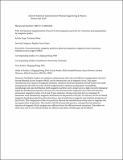Files in this item
Intraluminal magnetisation of bowel by ferromagnetic particles for retraction and manipulation by magnetic probes
Item metadata
| dc.contributor.author | Wang, Z. | |
| dc.contributor.author | André, P. | |
| dc.contributor.author | McLean, D. | |
| dc.contributor.author | Brown, S.I. | |
| dc.contributor.author | Florence, G.J. | |
| dc.contributor.author | Cuschieri, A. | |
| dc.date.accessioned | 2015-08-25T23:10:45Z | |
| dc.date.available | 2015-08-25T23:10:45Z | |
| dc.date.issued | 2014-11 | |
| dc.identifier | 159265976 | |
| dc.identifier | 358a6ef1-3db4-4920-ac0b-bf39e8fecd73 | |
| dc.identifier | 84922545081 | |
| dc.identifier | 000345108100022 | |
| dc.identifier.citation | Wang , Z , André , P , McLean , D , Brown , S I , Florence , G J & Cuschieri , A 2014 , ' Intraluminal magnetisation of bowel by ferromagnetic particles for retraction and manipulation by magnetic probes ' , Medical Engineering and Physics , vol. 36 , no. 11 , pp. 1521-1525 . https://doi.org/10.1016/j.medengphy.2014.07.013 | en |
| dc.identifier.issn | 1350-4533 | |
| dc.identifier.other | ORCID: /0000-0001-9921-4399/work/56638892 | |
| dc.identifier.uri | https://hdl.handle.net/10023/7328 | |
| dc.description | This work has been financially supported by the Engineering and Physical Sciences Research Council (EPSRC), UK, under Grant EP/HO 10033/1. | en |
| dc.description.abstract | Feasibility studies are needed to demonstrate that safe and effective manipulation of bowel during Minimal Access Surgery (MAS) can be obtained by use of magnetic force. This paper characterises two classes of magnetic particles: stainless steel microparticles (SS-μPs) and iron oxide nanoparticles (IO-nPs) in terms of their magnetisation, chemical composition, crystallinity, morphology and size distribution. Both magnetic particles were dispersed in a high viscosity biological liquid for intraluminal injection of bowel. Ex vivo porcine bowel segments were then retracted by permanent magnetic probes of 5.0 and 10 mm diameter. Strong retraction forces reaching 6 N maximum were obtained by magnetic fluid based on dispersion of SS-μPs. In contrast, the IO-nP-based magnetic liquid generated less attraction force, due to both lower magnetic and solution properties of the IO-nPs. The comparison of the two particles allowed the identification of the rules to engineer the next generation of particles. The results with SS-μPs provide proof on concept that intraluminal injection of magnetic fluid can generate sufficient force for efficient bowel retraction. Thereafter we shall carry out in vivo animal studies for efficacy and safety of both types of ferrofluids. | |
| dc.format.extent | 5 | |
| dc.format.extent | 723526 | |
| dc.language.iso | eng | |
| dc.relation.ispartof | Medical Engineering and Physics | en |
| dc.subject | Characterisation | en |
| dc.subject | Magnetic particles | en |
| dc.subject | Physical properties | en |
| dc.subject | Magnetic bowel retraction | en |
| dc.subject | Minimal access surgery (MAS) | en |
| dc.subject | QR Microbiology | en |
| dc.subject | RD Surgery | en |
| dc.subject | QC Physics | en |
| dc.subject | QD Chemistry | en |
| dc.subject.lcc | QR | en |
| dc.subject.lcc | RD | en |
| dc.subject.lcc | QC | en |
| dc.subject.lcc | QD | en |
| dc.title | Intraluminal magnetisation of bowel by ferromagnetic particles for retraction and manipulation by magnetic probes | en |
| dc.type | Journal article | en |
| dc.contributor.sponsor | EPSRC | en |
| dc.contributor.sponsor | EPSRC | en |
| dc.contributor.institution | University of St Andrews. School of Chemistry | en |
| dc.contributor.institution | University of St Andrews. Biomedical Sciences Research Complex | en |
| dc.contributor.institution | University of St Andrews. EaSTCHEM | en |
| dc.contributor.institution | University of St Andrews. School of Physics and Astronomy | en |
| dc.contributor.institution | University of St Andrews. School of Medicine | en |
| dc.identifier.doi | 10.1016/j.medengphy.2014.07.013 | |
| dc.description.status | Peer reviewed | en |
| dc.date.embargoedUntil | 2015-08-26 | |
| dc.identifier.grantnumber | EP/H010033/1 | en |
| dc.identifier.grantnumber | EP/K503940/1 | en |
This item appears in the following Collection(s)
Items in the St Andrews Research Repository are protected by copyright, with all rights reserved, unless otherwise indicated.

